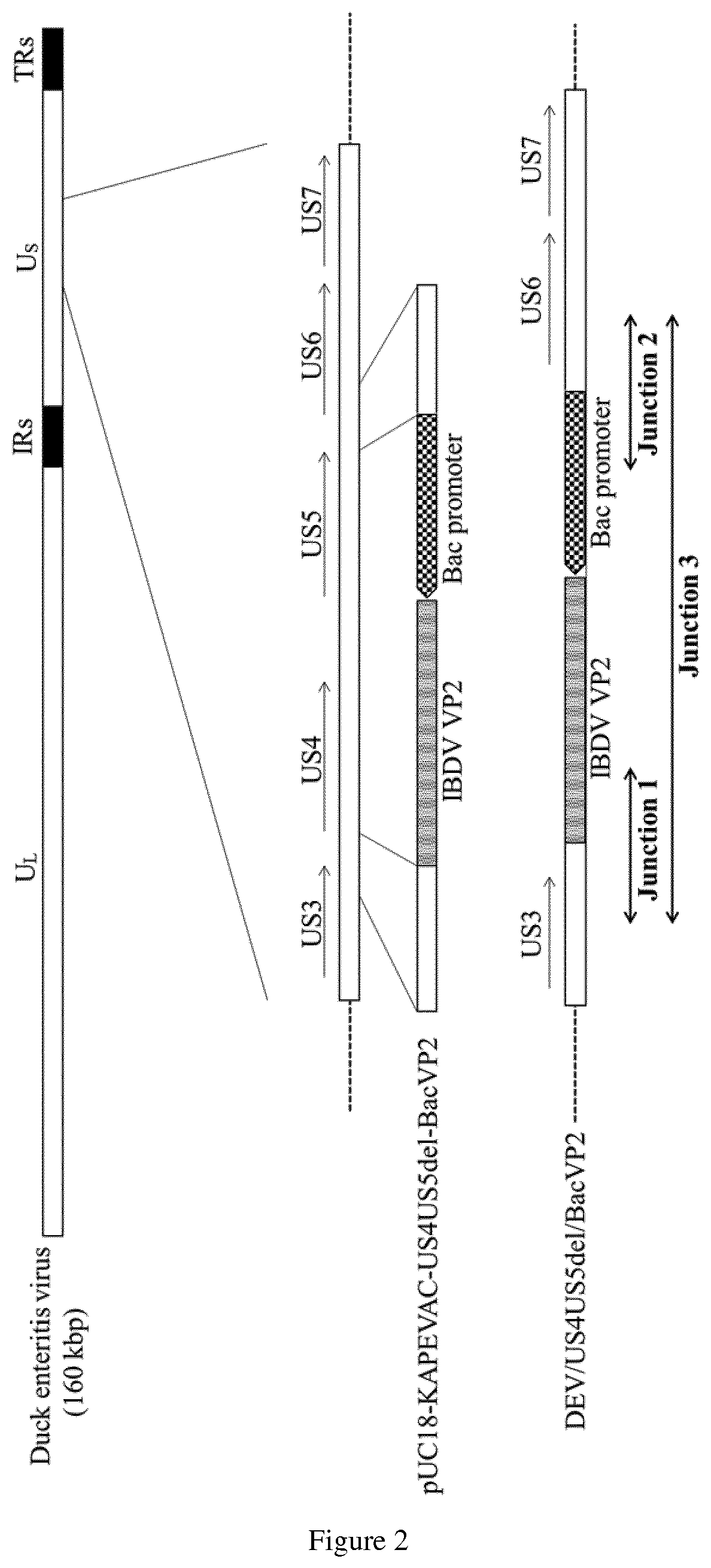Duck Enteritis Virus and the uses thereof
a technology constructs, which is applied in the field of duck enteritis virus constructs, can solve the problems of attenuation and defective devs, and achieve the effects of no risk of dissemination or contamination, fast growth rate, and high titers
- Summary
- Abstract
- Description
- Claims
- Application Information
AI Technical Summary
Benefits of technology
Problems solved by technology
Method used
Image
Examples
example 1
Virulence of Wild-Type DEV in Eggs or Young Poultry
[0130]A clinical study was performed to investigate the pathogenicity or virulence of DEV in chicken upon injection at different time schedule. More particularly, injection was performed in ovo (Day 3 before hatch), at Day 1 post-hatch, or at Day 4 post-hatch. DEV used was a wild-type DEV Jansen strain. The administered dose was either 100 or 1000 pfu / dose. As a control a PBS solution was administered. Pathogenicity was assessed by measuring mortality each day after hatch.
[0131]The results are presented in the following table.
[0132]
DoseNumber of birds to death in each day of age%GroupVaccinepfuRouteDay1nD 0D 1D 2D 3D 4D 5D 6D 7D 8>D 92Mortality1PBS—in ovo−3170000000002122DEV100in ovo−31632911—————1003DEV1000in ovo−3175291——————1004DEV1000sc1170000064211825DEV1000sc417000000000001Day of age at inoculation2Number of birds died between 9-day to 19-days of age
[0133]The above results show that injection of wtDEV at Day 4 post-hatch is sa...
example 2
Virulence of DEV Having an Inactive US4 or US5 Gene
2.1. Construction of DEV Comprising an Inactive US4 Gene or US5 Gene.
[0134]In an attempt to reduce the virulence to chick embryos, US4- or US5-inactive DEVs were constructed.
Construction of rpsLneo-DsRed2 Cassette
[0135]A 2.8-kb DNA fragment of rpsLneo-DsRed2 cassette was constructed by PCR reactions. Briefly, three PCR reactions were conducted. First PCR reaction was conducted using primer pair of SEQ ID NO: 1 (5′-GGCCTGGTGATGATGGCGGGATCGTTGTAT-3′) and SEQ ID NO: 2 (5′-CCATGGTGCTGCGCTCAGAAGAACTCGTCA-3′) with the template of synthesized fragment of rpsLneo (SEQ ID NO: 3). Second PCR reaction was conducted using primer pair of SEQ ID NO: 4 (5′-ACGAGTTCTTCTGAGCGCAGCACCATGGCC-3′) and SEQ ID NO: 5 (5′-TCGGAGGAGGCCATCCTTAAGAGCTGTAAT-3′) with the template plasmid of pSI Mammalian Expression Vectors (Promega, Cat # E1721). Third PCR reaction was conducted using primer pair of SEQ ID NO: 6 (5′-TACAGCTCTTAAGGATGGCCTCCTCCGAGA-3′) and SEQ ID NO...
example 3
Construction of DEVs Comprising Inactive US4 and US5 Genes
[0144]For construction of US4 and US5 inactive DEV, a homology vector was first constructed and then used to generate the virus by homologous recombination in E. coli. Plasmid constructions and DNA manipulation were essentially performed according to standard molecular biology techniques (Molecular Cloning: A Laboratory Manual. 4th Edition, Cold Spring Harbor Laboratory, Cold Spring Harbor, N.Y., USA, 2012).
Construction of the Homology Vector
[0145]A 1.1-kb DNA fragment of DEV genome flanking the US3 and US6 genes was cloned by PCR reactions adding SfiI recognition site at the insertion site. Briefly, using DNA extracted from DEV as a template, two PCR reactions were conducted. Primer pairs used are SEQ ID NO: 17 (5′-GCGCATGCTAGCTGATCTAACTTTAC-3′) and SEQ ID NO: 18 (5′-GGTGGCCAATAAGGCCTGACGGCAATATGT-3′), and SEQ ID NO: 19 (5′-TCAggccttattggccACCAGCTACACAAG-3′) and SEQ ID NO: 20 (5′-GCGAATTCGATTAATTCTCCCGAACTGTTG-3′). Another P...
PUM
| Property | Measurement | Unit |
|---|---|---|
| volume | aaaaa | aaaaa |
| nucleic acid | aaaaa | aaaaa |
| genome structures | aaaaa | aaaaa |
Abstract
Description
Claims
Application Information
 Login to View More
Login to View More - R&D
- Intellectual Property
- Life Sciences
- Materials
- Tech Scout
- Unparalleled Data Quality
- Higher Quality Content
- 60% Fewer Hallucinations
Browse by: Latest US Patents, China's latest patents, Technical Efficacy Thesaurus, Application Domain, Technology Topic, Popular Technical Reports.
© 2025 PatSnap. All rights reserved.Legal|Privacy policy|Modern Slavery Act Transparency Statement|Sitemap|About US| Contact US: help@patsnap.com



